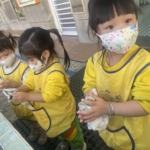Proper use of bleach disinfection Basic steps: "wear, dilute, wipe, stop, rinse, dispose":
(a) "Wear": Wear an apron, mask and gloves to protect your hands.
(b) "Dilute": Dilute the bleach according to the package instructions, so that you do not have to wash a tablespoon of commercially available bleach and add 10 liters of tap water (1250 cc per bottle for large bottles, 8 bottles of 10 liters) to mix it well.
(c) "Wipe": Wipe floors, sinks, faucets, toilets, doorknobs, tables and chairs, and other areas commonly touched by schoolchildren.
(d) "Stop": After wiping, let it sit for five to ten minutes, waiting for the bleach to kill the bacteria.
(e) "Rinse": Rinse or wipe the area that was cleaned and sterilized with water.
(f) "Abandonment": the following two methods can be used
1. Dilute the used bleach again with plenty of water (not less than 100 times) before pouring it into the kitchen sewer or outdoor gutter, so that it will not pollute the water source.
2. Store bleach in an airtight container so that it will oxidize over time before being poured out.
B. Notes on the use of bleach for disinfection:
(a) Disinfection should be done by rubbing, not spraying, and ventilation should be maintained.
(b) Apart from dilution with water, bleach must not be mixed with soap, detergents, pesticides, fragrances, etc. Otherwise, it may produce strong oxidizing effect and release toxic substances.
(c) If bleach accidentally touches the eyes, rinse with plenty of water for fifteen minutes, and if it touches the skin, rinse immediately with water until you feel clean.
(d) It is best not to pour the bleach directly into the toilet after use, as this will deprive the septic tank of its sewage treatment function and cause sewage to pollute the water source after discharge.
(e) Bleach bottles should be clearly labeled. Do not use soda pop bottles or any other beverage bottles to contain bleach to avoid accidental consumption by school children.





